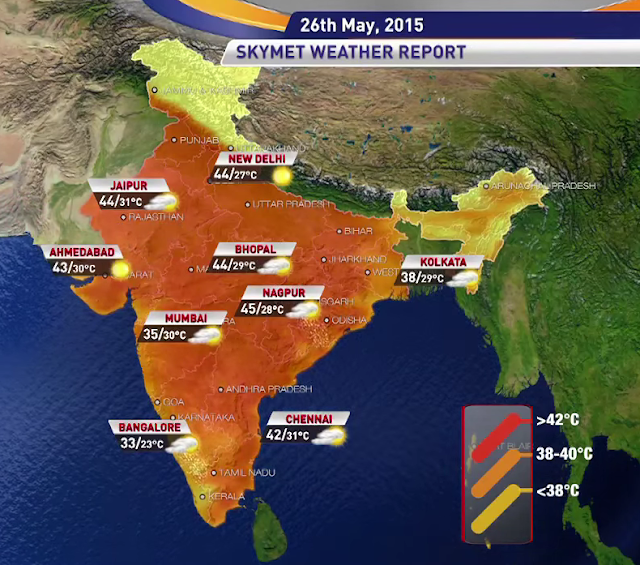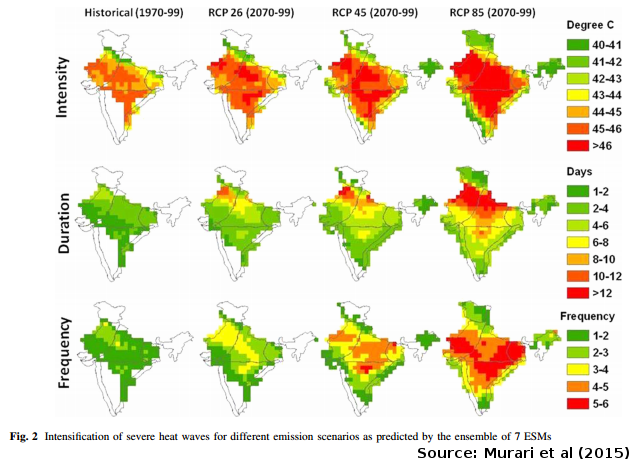India: Over 700 heat-related deaths as Climate change projected to intensify #heatwaves

According to a CNN report the heatwave has now killed more than 700 people in less than one week. You can probably expect the mortality to increase further in coming days.
The national capital of Delhi experienced it's hottest day, recording 45.5 degree celsius. The Palam observatory in Delhi recorded a maximum temperature of 46.4 degrees, according to The Times of India.
Saturday's minimum temperature in Delhi was 29.3 degrees, well above normal. The humidity wavered between 40 and 17 per cent. (Hindustantimes: Heat wave declared as Delhi sizzles at 44.5°C
Khammam in Telangana reached 48 degrees, breaking its previous record of 47.2 set in 1947. The Hindustan Times opened their story with "Humans “boil in their own skin” at 48 degrees Celsius, the maximum temperature recorded at Khammam in Telangana..."
A tweet by JPascal van Ypersele (@JPvanYpersele), a a Belgian Professor of Climatology and Environmental Sciences at the Université catholique de Louvain (UCL) and vice-chair of the IPCC stated, "Humans “boil in their own skin” at 48 deg Celsius, the maximum temperature recorded in Telangana, #India #climate http://t.co/U3lkhyLtXi
Most places in Rajasthan had temperatures hovering around 45 degrees. According to a report in the Hindustan Times, "Allahabad was the second hottest at 47.7°C, six degrees above normal; Nandigama in Andhra Pradesh was a notch under as it sizzled at 47°C while Odisha’s Angul district tipped the scales at 46.7°C.
“The conditions continuing since Wednesday is the result of a northwesterly dry wind blowing from Rajasthan and Gujarat and a surface trough running from Odisha to Tamil Nadu along the coast of Andhra. Cloudless skies allowing penetration of the sun rays which are absorbed by the land, adding to the heat,” said YK Reddy, director in-charge, meteorological centre, Hyderabad in the Hindustan Times report
According to the Indian Meteorological Department the heatwave conditions during the week ending 20 May 2015:
Heat wave conditions prevailed at many places over Vidarbha on 20th May; at a few places over Rajasthan on 17th, 18th & 19th; over Telangana and West Madhya Pradesh on 20th; over Vidarbha and Madhya Pradesh on 18th & 19th; and at isolated places over West Rajasthan on 16th, 17th & 18th; over Gujarat on 16th & 17th; over West Madhya Pradesh on 17th; over Marathawada and Telangana on 19th and over East Rajasthan & Coastal Andhra Pradesh on 20th.
In the bulletin of 26 May the Indian Meteorological Department said:
Heat wave to severe heat wave conditions are prevailing at a few places over Odisha and Coastal Andhra Pradesh. Heat wave conditions are also prevailing at a few places over Haryana, Chandigarh and Delhi, Rajasthan, north Madhya Pradesh and Chhattisgarh and at isolated places over West Uttar Pradesh, Jharkhand and Telangana.Minimum temperatures are above normal by 2-4°C at most places over Kerala; at many places over Rajasthan, Uttar Pradesh, north Madhya Pradesh, Saurashtra and Kutch, Odisha, Coastal Andhra Pradesh, Telangana, Konkan and Goa and Coastal Karnataka; at a few places over Uttarakhand, Gangetic West Bengal and Tamilnadu and at isolated places over Punjab, Haryana, Gujarat Region, Vidarbha, North Interior Karnataka and Rayalaseema. They were below normal by 23°C at many places over Jammu and Kashmir; at a few places over Himachal Pradesh and Assam and Meghalaya and near normal over rest of the country. The highest maximum temperature of 47.0°C was recorded at Angul (Odisha).
According to a Guardian report many of those reported dead are poorer people who are homeless and beggars, and labourers and construction workers on building sites working under the direct sunlight. It was reported that taxi drivers in Kolkata refused to work between 11am and 4pm due to the heat after at least two drivers died in their cabs due to the heat.
There were also reports of power cuts across India's poorly maintained and inefficient electricity network that is reliant on about 60 percent coal powered generation. Intermittent power and water supply often occurs during the stifling summer heat of the pre-monsoon season.
Summer is also when traditional power generation and transmission suffer losses due to extreme heat. Coal power pollution is already responsible for an estimated 100,000 deaths per year in India.
Rapidly expanding renewables of 100GW of solar power to the grid by 2022 will help ease power shortages and the stability of the electrical grid and drive creation of up to one million jobs. Solar power with either battery storage or local decentralised grid with battery storage, such as envisioned by Elon Musk in the rollout of Tesla Energy Powerwall product, may make a substantial difference in future to many rural communities in India, largely skipping the fossil fuel generation economy with all it's attendant pollution problems.
Many people seek some respite from the temperatures in shops , shopping malls, and Delhi's air-conditioned metro. Only about a third of the country's 1.2 billion people have direct access to electricity.
Day temperatures are forecast to fall by about 2° C over Andhra Pradesh,Telangana and Vidarbha from 28th May onwards leading to a slight abatement of heat wave conditions. The monsoon is expected to arrive from the start of June, to relieve extreme summer temperatures, but may take several weeks to reach the dry and hot north west states.
A Youtube report from France24.com dated 26 May 2015
Government health response has been to advise people to stay at home, drink lots of water to stay hydrated. Chief Minister of Andhra Pradesh, Chandrababu Naidu, announced on Saturday a compensation of Rs 1 lakh each to the kin of those who have died of sun-stroke. “We are announcing Rs 1 lakh as compensation for each victim of heat wave,” he was quoted as having said. (Rs 100,000 = approx US$1500)
There is definite room for improvement in health warning alerts, public health warnings and education, and incorporating heatwave response as part of disaster management plans.
Pre-monsoon heatwaves projected to start earlier, with greater intensity and frequency
While the current heatwave may be still within the realms of natural variability it fits the trend for intensification of severe heat waves in India and the growing impact on heat stress and mortality. A study by Kamal Murari and colleagues (2015) published in Regional Environmental Change highlights this climate trend. The abstract to the study - Intensification of future severe heat waves in India and their effect on heat stress and mortality - reads:
Heat waves are expected to intensify around the globe in the future, with potential increase in heat stress and heat-induced mortality in the absence of adaptation measures. India has a high current exposure to heat waves, and with limited adaptive capacity, impacts of increased heat waves might be quite severe. This paper presents the first projections of future heat waves in India based on multiple climate models and scenarios for CMIP5 data. We find that heat waves are projected to be more intense, have longer durations and occur at a higher frequency and earlier in the year. Southern India, currently not influenced by heat waves, is expected to be severely affected by the end of the twenty-first century. Projections indicate that a sizable part of India will experience heat stress conditions in the future. In northern India, the average number of days with extreme heat stress condition during pre-monsoon hot season will reach 30. The intensification of heat waves might lead to severe heat stress and increased mortality.
The projected intensification of heatwaves will increase heat stress in labour productivity as discussed by Dunne et al (2013) See my February 2013 review article: Climate change to increase heat stress, reduce work capacity.
The researchers of the Indian study argue that, if mean temperatures were increased by 3 C, a large part of India could experience extreme heat stress conditions. They note in their study that projections of climate conditions by mid to the later part of the century show a great many more extreme stress days over a large region of India.
The study highlights that in particular northern India is projected to experience extreme heat stress in the future. This projected increase in heat stress combined with the lack of infrastructure, high population density and large workforce in agriculture, is likely to lead to substantial heat-health risk to the population of northern Indian states.
The study projected mortality impacts for four Indian states: Delhi, Rajasthan, Maharashtra and Orissa. The results of the modelling projections show that:
"heat wave induced mortality in Delhi is projected to be higher, followed by Orissa, Maharashtra and Rajasthan. In the period 2010–2039, mortality projections under all three scenarios and by all the models are similar. The projection of mortality for Maharashtra is more than double that of the historical period. Furthermore, we observe that mortality projections under RCP26 are not very high, except for Maharashtra. This suggests that heat wave impacts could be limited if global warming is restricted to 2 C."
Climate adaptation will be an essential feature of dealing with heatwaves of the future in India, and the researchers indicate that the first step is alerting policy makers in the government to plan an adequate public health response, including a better warning system, as well as a heatwave adaptation policy as part of preventative disaster management plans.
Already the National Disaster Management Authority (NDMA) has decided to recommend inclusion of heatwaves as one form of natural disaster. "I have been interacting with the home ministry and very soon there will be a decision on the inclusion of heat wave in the list of natural disasters," NDMA vice-chairman Marri Shashidar Reddy told the Times of India.
The researchers also called for more extensive and elaborate research to better understand the risks of such catastrophic events in the future.
Sources:
- Murari, K.K., Subimal Ghosh, Anand Patwardhan, Edoardo Daly, Kaustubh Salvi (2015) Intensification of future severe heat waves in India and their effect on heat stress and mortality. Regional Environmental Change April 2015, Volume 15, Issue 4, pp 569-579 DOI: 10.1007/s10113-014-0660-6 (abstract)
- Two still images from 26-05-2015 - Skymet Weather Update youtube video
- Map image of monsoon approach from Indian Meteorological Department.
John Englart (@takvera) and his teenage daughter Tarryn Clancy (@climateteen) will be travelling to Paris to report on the United Nations COP21 climate talks (including for Australian citizen journalist site Nofibs), and in particular what role Australia plays in those negotiations.
Get Involved
If you'd like to help with maintaining or developing the website, contact us.
Publish
Publish your stories and upcoming events on Indybay.





